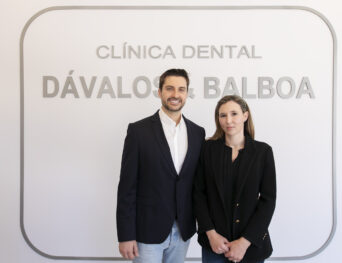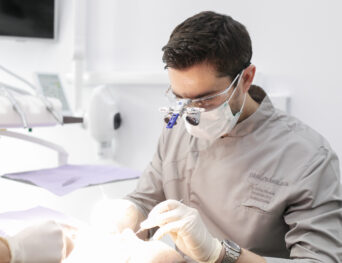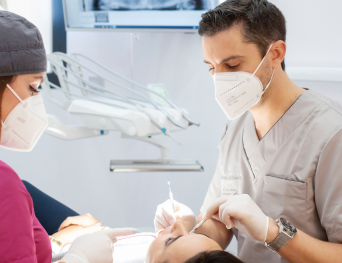Periodontics and gums
In the dental clinic Dávalos & Balboa, in Murcia, we attach great importance to periodontics. Periodontics is a medical-surgical dental specialty that studies the prevention, diagnosis and treatment of diseases and conditions that affect the tissues that support the dental organs (gum, periodontal ligament, root cement and alveolar bone) and implanted substitutes, for the maintenance of the health, function and aesthetics of the teeth and their adjacent tissues.
Periodontal Diseases or Periodontitis are a set of pathologies that affect the support device of the tooth, that is, the whole of the alveolar bone, the periodontal ligament, the root cement and the connective and gum tissue, which are the tissues responsible for Keep the tooth in our mouth. Initially they can start as a simple inflammation of the gums (Gingivitis) or evolve into a serious disease that causes total loss of teeth. They would be different stages of the same clinical entity.
In early stages, periodontitis is usually a disease of slow progression, asymptomatic and does not cause pain, so many patients do not detect it until the condition has progressed enough to cause dental mobility. In its severe form there is erythema, edema, bleeding and gingival recession, mobility and / or dental migration, suppuration from periodontal pockets and dental loss. The destruction it produces is irreversible and affects various aspects of daily life and quality of life, decreases trust, social interaction and food choices.
The prognosis of periodontal disease depends largely on an early diagnosis, adequate treatment, and the consolidation of healthy oral hygiene habits.
What causes Periodontal disease?
The mouth is full of bacteria normally. The bacterial accumulation that occurs around the teeth is called dental plaque.
The bacterial plaque is a heterogeneous set of a varied microbial flora, aerobic and anaerobic, surrounded by an intercellular matrix of polymers of salivary and microbial origin. These microorganisms adhere to the surfaces of the teeth, especially in retentive areas, such as molar grooves, dental necks, periodontal pockets,…. Its presence can cause cavities, gingivitis and periodontal disease.
Redness and inflammation of the gum or bleeding with brushing are usually the first signs of gingivitis. If the disease is ignored, the destruction of the supporting tissues of the tooth begins.
Dental plaque forms on the surface of teeth, gums and restorations, and can hardly be seen, unless it is stained. Its consistency is soft, matte, white-yellow. It forms in a few hours and is mainly removed with the mechanical drag of the toothbrush. Brushing and flossing help remove this plaque. In addition, it can be eliminated with jets of pressurized water such as those offered by dental irrigators. The most important for its elimination is the mechanical drag of the bacterial plaque. It varies from one individual to another, and its anatomical location also varies. If dental plaque is calcified, it can lead to the appearance of calculi or tartar tartar. These calcified deposits can already be removed by brushing. What is very important to know is that the longer plaque and tartar remain on the teeth, the more damage they cause.
Gingivitis is an initial stage of periodontal disease, in which there is still no bone loss, but if not treated properly, it evolves into periodontitis. In periodontitis, the gums move away from the teeth and form spaces or bags that become infected. The body’s immune system fights bacteria as plaque spreads and grows below the gum line. The toxins of the bacteria and the body’s natural response against infection begin to destroy the bone and connective tissue that hold the teeth in place. When periodontitis is not treated properly, the bones, gums and tissues that support the teeth are destroyed. Over time, the teeth become loose and fall out.
Main Risk Factors:
- Smoking Want another reason to quit smoking? Smoking is the most important risk factor related to the development of periodontal disease. In addition, smoking may worsen the prognosis of some treatments.
- Diabetes. Bidirectional Relationship People with diabetes have a risk approximately three times that of the general population to develop periodontal disease, due to damage to the microvasculature of the periodontium. In addition, periodontal disease has a worse prognosis in the diabetic patient, especially if there is no good glycemic control. On the other hand, periodontal disease has a negative effect on glycemic control, so we say that the relationship is bidirectional.
Who gets gum disease?
Generally, people do not show signs of gum disease until they are between 30 and 50 years old. Men are more likely than women to have gum disease. Although it is rare for adolescents to develop periodontitis, they can develop gingivitis, the mildest form of gum disease. Typically, gum disease develops when plaque is allowed to accumulate along and below the gums.
How do I know if I have gum disease?
Symptoms of gum disease include:
Constant bad breath
Red or swollen gums
Gums very sensitive or bleeding
Chewing pain
Dental mobility
Sensitive teeth
Receding gums or teeth that look longer than normal.
Any of these symptoms may be a sign of a serious problem that should be examined by the Specialist of the dental clinic of Murcia Dávalos & Balboa (Periodontist), Dr. Balboa.
How is gum disease treated?
The main goal of treatment is to control the infection. The amount and types of treatments may vary depending on how far the gum disease has spread. Any type of treatment requires the patient to continue with good daily care of the teeth at home. The Periodontist may also suggest that you change certain behaviors (for example, that you quit smoking), as a way to improve treatment outcomes.
How can I keep my teeth and gums healthy?
Brush your teeth twice a day (using a fluoride toothpaste).
Use dental floss regularly to remove plaque from between teeth. Or, you can use a special brush to clean between your teeth or a wooden or plastic stick that is recommended by a dental health professional.
Can gum disease cause problems that go beyond the mouth?
In some studies, researchers have observed that people with gum disease (compared to those without the disease) are more likely to develop heart disease or have problems controlling the level of blood glucose (blood sugar) . Other studies show that women who have gum disease are more likely to have premature or low birth weight babies than women with healthy gums. However, until now, it is not known if this is due to gum disease.
There may be other reasons why people with gum disease sometimes develop additional health problems. For example, something may be causing both gum disease and other medical problems, or it may simply be a coincidence that gum disease is present in conjunction with the other health problems.
Gingivitis and periodontitis make up the two major pathological groups of periodontal disease. This is an inflammatory disease of bacterial origin that causes a series of signs, from gingival inflammation and bleeding gums to finally losing teeth. Gingivitis is a reversible inflammatory lesion where there is no loss of supportive tissues (bone, periodontal ligament and gum). Periodontics and gums are the terms used for the specialty and the “visible” reflex thereof.
Periodontitis (formerly called Pyorrhea), is an irreversible and cumulative infection caused by bacteria that are in the bacterial plaque and tartar, these cause the resorption of the supporting tissues of the tooth. When losing tissues, the teeth move and, in advanced cases, fall out or require removal.
If gingivitis is maintained for a long time and there are other factors (genetic, environmental, local, …), periodontitis begins, in which, in addition to the inflammation of the gum already mentioned, there is a deeper destruction that affects to the supporting tissues of the tooth, that is, the alveolar bone, the cement of the tooth and the periodontal ligament. It is an infection produced by the bacteria that are in the bacterial plaque and tartar, these cause the resorption of the supporting tissues of the tooth favors the further progression of the disease, by creating a space under the gum that we call periodontal pocket, in which increasingly accumulate more bacteria that can endanger the survival of teeth.
Can periodontitis be cured?
Periodontitis is treated, if it is detected in early or moderate stages, loss of teeth could be avoided. In certain more advanced cases, with the treatment, the life of the teeth can be extended.
What is the treatment of periodontitis?
The main goal of treatment is to control the infection and restore the gum-tooth junction by preventing the entry of microbes between them. The treatment of periodontitis is aimed at reducing the pathogenic bacteria that are part of the bacterial plaque that accumulates under the margin of the gum, after a thorough clinical examination (with periodontal probe) and radiographic.
The first phase of the antibacterial treatment consists in scraping and smoothing the affected root inside the periodontal pockets and removing from the tartar that is attached to the root under the gum (scraping and root smoothing); This treatment has been shown to significantly reduce the risk of dental loss, reducing the speed of disease progression and improving gingival health. It is not painful or causes inflammation of the face and the patient can live a normal life.
Approximately one month after the completion of the scraping phase, a reassessment is carried out, whose objective is to evaluate the response to the treatment and determine if any additional treatment is necessary.
All types of clinical treatment require that the patient maintain excellent oral hygiene every day, and go to the periodontal periodic maintenance programs every 3-6 months (depending on the peridontal involvement, type of patient and his collaboration in his oral hygiene , tobacco consumption, ..), preventing periodontitis from manifesting itself once the disease is cured.
Our treatments
-
Radical Coating Techniques
Radical Coating Techniques The gum can suffer recessions due to different factors, but especially…
+ See more
-
Gingivitis and Periodontitis
+ See more
-
Gingivectomy
Gingivectomy Gingivectomy is a surgical procedure performed by the periodontist in which a little…
+ See more
-
Periodontal surgery
Periodontal surgery Periodontal surgery treatment at the Dental Clinic in Murcia Dávalos and Balboa
+ See more
-
Root smoothing
Root smoothing Root smoothing treatment at the Dental Clinic in Murcia Dávalos & Balboa….
+ See more
-
Coronary extension
Coronary lengthening Coronary lengthening is a solution for periodontal, restorative and aesthetic problems. Sometimes…
+ See more










